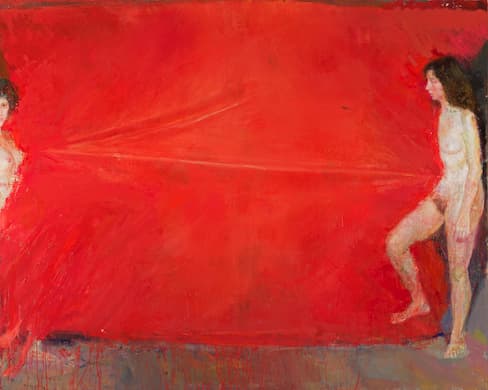At Athens, Appreciating the Modernism on Offer at the Basil and Elise Goulandris Foundation
A gallery set aside for modern and contemporary Greek artists proves that localism has its benefits. Only a snob would fob off the best of the artists as being derivative of international trends.

Among the signal — and haunting — accomplishments of 20th century art is a series of paintings by Pierre Bonnard dedicated to the subject of a woman at her bath. Although we know the identity of the model as being the French painter’s wife, Marthe de Méligny, the pictures are less biographical aperçus than elegiac registrars of sensation, evocations of memory that have been simultaneously distilled and elaborated upon.
No fan of the reticent Frenchman, Pablo Picasso stated that with a Bonnard painting “you never once get the big clash of the cymbals.” To which one can only respond: Exactly. High drama has its satisfactions and its place, but so, too, do aesthetic turns of a more nuanced variety.
I was reminded of Pablo, Pierre, and the vagaries of artistic temperament upon visiting the Basil and Elise Goulandris Foundation at Athens, Greece. The collection not only boasts Picasso’s “Nude Woman With Raised Arms” (1907), a fearsome adjunct to the Museum of Modern Art’s “Les Demoiselles D’avignon,” but “Getting Out of the Bath” (circa 1926-30), Bonnard’s kinder and gentler “potpourri of indecision.” Again, the quote comes from Picasso.
The Goulandris picture is an atypical Bonnard. Although it’s no clash of cymbals, neither does the canvas trade in the ghostly sonorities typical of the artist. Mademoiselle de Méligny is pictured as a kind of feral entity, gripping onto the edges of the tub with a tensile sense of expectation. The surroundings, with their sonorous array of purples, ochres, and aquamarines, are up-ended if not altogether teetering. Bonnard’s feathery touch mitigates a composition whose lopsidedness is among its chief attractions.

The Goulandris Foundation is reminiscent of the Kimbell Art Museum at Fort Worth, Texas — that is to say, a collection that favors the exemplar over the encyclopedic. Modernism is the Goulandris’s focus, with Post-Impressionism and the early avant-garde being well-represented. There’s also a gallery devoted to decorative arts from China and Japan, as well as a lone foray into the Renaissance: “The Veil of Saint Veronica” (early 1580s), by hometeam favorite Doménikos Theotokópoulos, better known as El Greco.
The museum that bears his name at Pangrati, a neighborhood off the beaten path of more touristy destinations, was Goulandris’s second venture into establishing a cultural institution. In 1979, the Greek-born shipping magnate and his wife, the former Elise Karadontis, founded a museum of contemporary art on Andros, the northernmost of the Cycladic Islands. Neither lived long enough to see the Athens museum open its doors to the public in 2019, but they had to know the collection would hold its own in a city rich with archeological and artistic treasures.
Besides Picasso and Bonnard, the Goulandris features works by Vincent van Gogh, Claude Monet, Auguste Rodin, Henri de Toulouse-Lautrec, George Braque, Edgar Degas, Amedeo Modigliani, and, in a self-portrait whose potency belies its petite scale, Paul Cezanne. Names that are less well known are sometimes preferable to the star players, including Germaine Richier, Jean Helion, Barbara Hepworth, Aristide Maillol, and Nicholas Krushenik — all of whom are stellar enough to forgive the odd bum steer like Roy Lichtenstein, A.R. Penck, or Ed Ruscha.
The gallery set aside for modern and contemporary Greek artists proves that localism has its benefits. Only a snob would fob off the best of the artists as being derivative of international trends: The work is that impressive. Particularly noteworthy are Yannis Pappas’s uncanny bronze “Woman with Octopus” (1959), Panayiotis Tetris’s painterly tour-de-force “Street Market” (1981) and, especially, George Rorris’s “Large Study in Cadmium Red” (1987-88), a canvas that flirts with abstraction even as it hews to an unforgiving strain of realism.
Is Mr. Rorris’s picture reason enough to visit the Goulandris Foundation? Standing in front of the thing, it would be hard to say no. Yet the museum has more than enough to offer to make the question moot.

